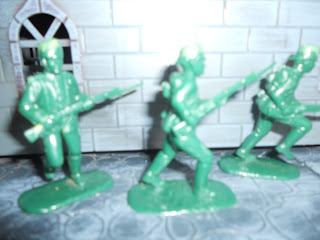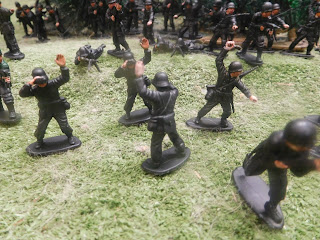One Campaign Ends & Sixty-four Years Later Another Begins; Bring Out Your Dead!
Today, the war between Beerstein on the one hand and Bogavania and Fezia, on the other ended. No further battle occurred on map move 15 as both sides were running dangerously close to starvation and absence of ammunition. The war had dragged on and seriously drained the resources of both sides. The army occupying the Bogavanian capital had compeltely run out of supplies, including captured ones.
Beerstein captured two Bogavanian castles, including the capital, and two Fezian ones, as well as capturing a Fezian mine and a village. Bogavanian armies were wiped out and the king and his potential successors captured. Fezia still had a large army in the North and a smaller one in the capital. From now on Bogavania is relegated as a province of Fezia.
Sixty-four years of peace followed, with Beerstein consolidating its conquests. Most of the commanders and leaders of both sides died by the end of that time. One Beersteiner hero, only a teenager in the campaign is still alive. One Beersteiner wizard has also, despite advanced years, by virtue of his magic, survived the years.
Now new enemies have appeared. Beerstein is about to go to war with Necrolia. Necrolia consists of vampire lords, undead necromancers and slavering armies of skeleton warriors, zombies, mummies and horrific undead monsters.
Fezia faces the armies of Aztecia. The majority of Aztecs are light warriors but some of these being elite 'animal knights' dressed as jaguars, eagles and so on. A small number have donned heavy armor and learned to ride horses, but the latter's horsemanship does not equal the horsemen from the Silver Horde. They also have tamed the 'Cold Ones,' mainly enormous plant eaters but also a few carnosaurs. (Fezia and Beerstein no longer have their own Cold Ones. Interestingly, although called cold ones. Some scientists of Fezia and Beerstein have speculated that they actually have warm blood).
RELATIVE ADVANTAGES AND DISADVANTAGES OF ARMIES
BEERSTEIN
Crusaders - have great close combat skill, plate armor and resistance to magic
Plate armored cavalry with carbines and pistols
Plate armored knights
Knights in plate armor - useful against hordes of undead
Light cavalry with carbines and pistols
Longbows - excellent ranged weapons and ability to move and shoot.
Crossbows
Cannons, including improved faster firing cannons and horse artillery.
Muskets, updated to include flintlocks, less vulnerable to wet weather than matchlocks.
Some mercenaries - Hillmen and mounted light and medium horse archers
Rare Units; Giant, wizards
Heroes
Clerics
Archbishops
Church
FEZIA/BOGAVANIA
Mounted light and heavy horse archers (Fezia)
Light cavalry with carbines and pistols
Plate armored infantry (Fezia) and knights (Bogavania)
Plate armored cavalry
Elite Mounted winged archers
Cannons (as for Beerstein)
Muskets (as for Beerstein)
Longbows (limited to Bogavanian forces)
Shortbows, (Fezia) less effective but cheaper than longbows and muskets
Crossbows (Bogavania)
Some mercenaries - Hillmen and mounted medium horse archers
Fezian War Elephant
Rare Units and characters - Fezian Genie, Giant, wizards
Heroes
Clerics - increase leadership of units and magic resistance
High cleric
Temple
OTHER POSSIBLE OPTIONS (for Beerstein and Fezia/Bogavania)
Magic Weapons for use by heroes
Dwarf unit
Flying creature for hero to ride.
NECROLIA
Vampires - close combat and magical devastation!
Skeleton units - Sturdy and persistent
Zombies - persistent but stupid. May increase in numbers from enemy dead for next battle if Undead win.
Bats and other flying creatures - good for outflanking and infiltration
Undead monsters. Horrific close combat
Mummies - can hypnotize and paralyze members of enemy units nearby or in close combat with
Catapults
Undead bowmen are lousy shots.
Black magic - from Vampires and Necromancers.
Resistance to sunlight Vampires can create clouds over themselves to block the deadly sunlight. However, this is less effective in desert regions.
Necromancers can create more skeleton and zombie warriors.
Rare Units - Black Coach
Zombie dragon
Also available to characters: magic weapons and flags
Undead armies need fewer supplies
Many units cause fear or terror
Weaknesses: Skeletons and zombies are persistent and don't need leadership tests to attack but will lose more members if they lose combat. Also, loss of the general will lead to rapid decreases in numbers of Undead.
Enemy clerics can cast Undead Crumble prayers/spells.
No gunpowder weapons
AZTECIA
Fight well around shrines and temples - bonus
Wizards
Priests
Includes elite light units
Dinosaurs! May have limited numbers of large plant eating dinosaurs with howdahs. Cause terror.
Bowmen (short bows)
Small number of light cavalry
Small number heavy armor
Rare - Carnosaur mounts large and super large (rarer)
Disadvantages:
Short range weapons and no artillery. No firearms. Few fast troops.
Sacrifice: Mixed blessing. Aztecs may waste time trying to stun rather than kill enemy. If they take them to a place of sacrifice it increases the power of wizards and increases leadership of the army.
Must take morale tests when first shot at by cannons or charged by plate armored cavalry. (however, the latter must test for exhaustion in the topical heat!)
Mercenaries: Patran hoplites. One unit per army
GENERAL COMMENTS
It is assumed that our countries have moved on in technology but have the option of retaining some earlier weapons and troops types. The maximum level previously reached was equivalent to the English Civil War but we are now reaching early 18th century level.
FIGURES
The Fezians require more unusual looking musket men so there will be some conversions happening.
American Revolution troops will be increasingly making their appearance, and possibly some Napoleonic ones. The main change will be the addition of different flags.
I am going to make additional zombie figures; see below:
As you can see there are some zombies with screwdrivers in their eyes and munching on hands. I removed some of these. The cowboys and Indian have a potentially shambling look. The skeleton dinosaur may have his head added somewhere in there.
I am presently rearranging the war rooms for some repairs so it might be a few weeks before we get back to this. i am also going to have to draw additional maps and paperwork.












I am continually impressed by how you repeatedly manage to do what so many wargamers (myself included) fail to ever accomplish: run a long and successful campaign!
ReplyDeleteHow did you determine 64 years for the advancement? Is there some significance to that number or was it randomly determined?
The campaign length is arbitrarily set at 12 moves (same as out tabletop battles). Then we roll the dice to see if the campaign (as with table top battles) continues. So it went for 15 turns. (In these turns there are not always battles there might be two or three).
DeleteSo, once it is determined the campaign ends we roll a percentage die. Sixtyfour was the result. Then we roll on a chart to see what war will happen. I increased the odds on the chart for us battling new enemies. My country's new enemy is very formidable although I have more ranged weapons. I don't yet know the size of Necrolia. The map size will be randomly rolled for but Necrolia needs less land to feed its 'men' as most are undead! Do they need supply wagons? I suppose wagons full of corpses could be used and wagons with stones for the catapults! Aztecia is closer, in size to Fezia so resources could be similar.
One thing I found still challenging was keeping records of credits or supplies. To ensure we keep our records up to date, I'll make these recorded down at the end of battles. I have been careful to write down surviving numbers for units at the end of the games but not credits, at least not on the blog. There is something to be said for not doing so as to not let the enemy know too much but the blog is a good way to keep records easily accessible.
One of the simplest and most effective devices was saying half of casualties return for the next battle or one quarter if an army leaves the field. Then armies must rest a map move before being able to move.
A good device was to say a village could support two units so as to alleviate supply problems.
So, we have a level of complexity mixed with simplicity. For example, so far we have not differentiated between different types of supplies, just saying any unit (unless at half or less) consumes one credit per turn and that a wagon carries ten credits. The wagons may be kept in an adjacent hex and still supply the army or may come on from reserve. Enemy wagons can be captured and used. This happens either in the battle or if the other side moved units into that adjoining hex from which the enemy just moved. (as artillery also comes from reserve there is also a chance of it being captured).
Winning a battle may also lead to capturing enemy supplies.
Now so many years have passed we determined that most of our characters have either died or are too frail to take part so we will have to generate new ones. However, we may recycle some by simply placing new labels on the bases. The great thing about being a fantasy game is we can also use figures from different eras so our figures can range from ancient to 18th century.
After another two campaigns we might reach 19th century levels of technology. We are assuming our world corresponds to the real one, at least in that respect.
Another thing is that third parties may adapt some technology from our countries. We have assumed that the Aztecs have adopted some cavalry and armor. The Patrans now have cannons although not so modern ones. (Imagine Timpo Romans manning cannons). one question will be can non-human countries adapt new technology or just rely on the supernatural.
One unusual thing is we have decided that magic can continue to be used even as technology advances.